10 Types of Chimneys That are Safe, Effective, & Attractive
Author: Omar Alonso | Editor: Omar Alonso
Review & Research: Jen Worst & Chris Miller
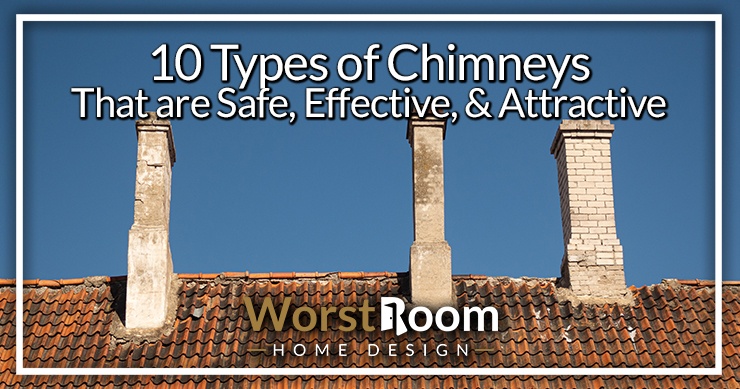
If you have a fireplace inside your home, you definitely know about the importance of a decent chimney. In the majority of the houses, we can observe all types of chimneys installed on rooftops. What purpose does it have beyond the obvious?
Well, not only does it complements the architectural frame, it does a far greater job in dissipating heat from the fireplace and stoves inside your home, keeping your house cool and fume-free during winter days.
Chimneys have different variations, and not every type will suit your structural needs. In this article, we will discuss different types of chimneys to give you a clear sight of the contrasting differences and allow you to pick the best one for your home.
10 Types of Chimneys
The first thing to remember is that not all chimneys are the same, just as there are many types of fireplaces. Well, they are made for the same purpose, to eliminate fumes and heat, but they have structural differences, material differences, varying shapes, and sizes, etc.
Moreover, the most common chimney is probably the orthodox brick structured ones. That's not all, there are many other diverse options. Below, you will get to know about some of the most practicable chimneys out there.
Masonry Chimneys
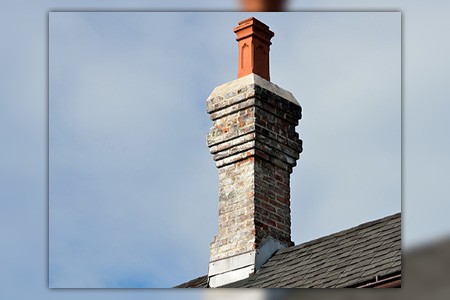
Didn't we just mention the common brick chimney? This particular kind is known as masonry chimneys and is also made with materials like stones, blocks, cement, and mortars.
A positive about such chimneys is that the brick material does play a role in trapping heat and radiating it to the rooms to keep the interior warm at low temperatures. That being said, the pipeline in the chimney pipe effectively takes out the smoke and flushes it into the open air without hurdles.
Masonry chimney styles are tailor-made for masonry style furnaces by the wall. Such types of furnaces are very striking to the eye and make your home interior look beautiful and elegant.
Masonry chimneys are super durable compared to other options and are equally as effective for saving you from the cold. The homeowner must make sure they take care of it, in terms of maintenance to make it last longer.
Setting up a masonry chimney requires a solid base foundation because it is heavy on the top and will require proper cementing. The resale value of these chimney options is pretty good even in recent times. If you visit an old home, you are likely to see a masonry chimney standing tall.
Metal Chimneys
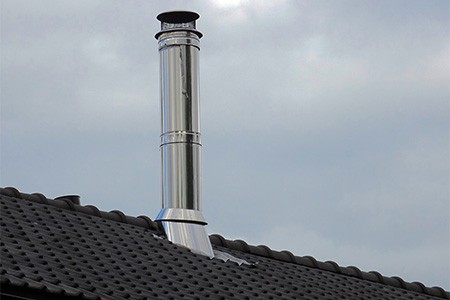
The name says it all. This is a kind of chimney made with metal, mostly stainless steel, to give a more industrial look to it. Metal chimneys are not as eye-catching as the masonry units, but that depends on the users' preference to be honest. Metal options look more like parts of a roof than standard chimneys.
Metal chimneys acquire a lot of space during the installation and can also be on the expensive end if you are looking for a bigger setup. This chimney has a double or triple layer of wall, with insulation in between the frames to dissipate heat properly.
To make the metal chimney look aesthetical, many people prefer to cover it with casings such as sided frames, wooden structures, and masonry chimney cases.
The most commonly used material that makes up metal types of chimneys is bare stainless steel or galvanized steel. This is believed to provide a more hi-tech outlook. The venting system is crafted with metals suited to deal with the fuel they exhaust.
Metal chimneys are not as flexible as other chimneys and are restricted to only 15 to 30-degree angles. So if flexibility is your concern, metal chimneys might not be the best pick for you.
Prefabricated Chimneys
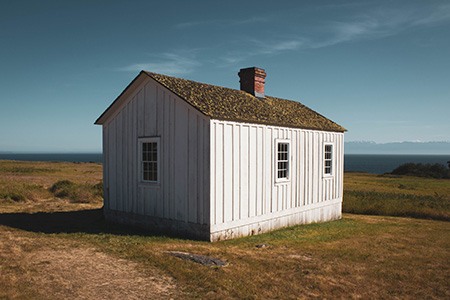
Just like the name suggests, a factory-built chimney is made in the factory, and you get it all assembled before putting it on top of your building. These are more modernized compared to the ones on our list.
The good thing about prefabricated chimneys is that they also come in sets, for example, chimneys and fireplaces or fireplace alternatives in a bundle.
A downfall is that prefabricated chimneys might not settle on top of any fireplace, they could be designed to fit a particular kind. So before purchasing, it's advised that you look into the compatibility.
The only downfall of such an item is that it is not as durable as orthodox chimney styles and will deteriorate over time, and you will have to perform repair and replacement tasks too often.
However, the best you can do is to get a chimney and fireplace in tandem so that one complements the other. This type of chimney is very popular amongst modern-day housings and gives its user the upper hand to customize the design layout.
There are different kinds of factory-built chimneys in the market. Let's take a look at the most common ones.
Air Cooled Chimneys
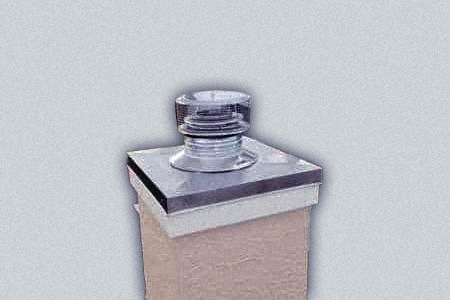
This is a type of chimney where the metal sheets have air pockets in between the layerings. This feature helps to circulate the air and dissipates the heat within the metal.
The air gaps also absorb heat from the pipes as the smoke rises and keeps the home interior relatively cool. Air-cooled chimney options are the least expensive kind when it comes to factory-built chimneys. They're also much more lightweight than an insulated chimney.
They do have a downside of having over-the-top condensation in cold temperatures, which can lead to corrosion and will need early replacement.
Double Wall Chimneys
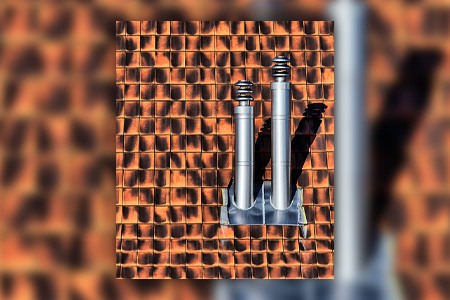
For effective termination of heat, these types of chimneys are made with double layers of metal, mostly stainless steel. In addition, there is an insulating layer placed in between the walls to curb the heat generation within the metal frames.
These are more expensive and heavy than the air cooled pipe above, but they create a better draft to essentially suck the hot air outside. This is because the gases inside the chimney stay hotter due to the insulation. Refractory insulation blankets used within help ensure you don't develop a hot spot within the chimney, which could result in a fire.
Double-wall chimneys look like stuffed pipes wrapped inside another large piping. If none the wiser, you wouldn't be blamed for confusing these with types of roof vents. The insulating material between the two surfaces is what performs the magic in keeping a house cool.
Installing the double-wall chimney is fairly easy and won't require excessive tools. It is also lightweight compared to brick chimneys, so this has been a crowd favorite for ages.
Air Insulated Chimneys
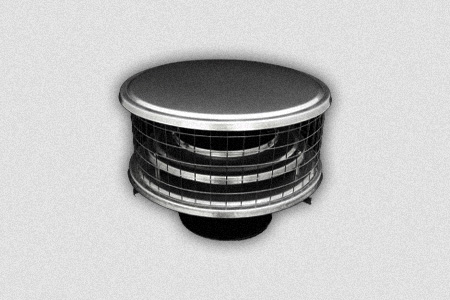
It is similar to the air-cooled one but differs in terms of insulation. The air-cooled chimney moves air in between the metals to keep the temperature cool, whereas air-insulated products have an air chamber to insulate the piping.
Rather than drawing away from the heat, the air chamber here works like an insulator which is ideal for colder temperatures. Air-insulated chimneys are hard to install but not impossible.
The positives it boasts certainly make it a purchase-worthy chimney. Even if the price is a tad higher than other chimney options, it is worth the hype.
Combination Types of Chimneys
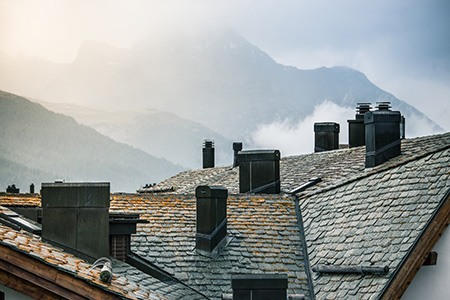
This is more like a hybrid chimney because it takes features from all the chimneys we mentioned under prefabricated items. Take, for example, combination chimneys that can have double walls, air insulation, and air cooling all in one unit or you can alter the aspects as you wish.
This stellar feature gives the homeowner a sigh of relief as they can tweak around with their chimney ideas and show off their creativity to make the house look beautiful and functional in terms of eliminating heat and smoke.
Free-Standing Stove Chimneys
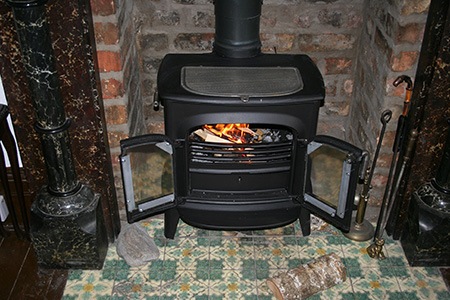
A free-standing chimney is very versatile, you can either put in a masonry chimney or factory-made types of chimneys without any fuss. It is a custom-built stove chimney that is interconnected to a free-standing stove.
Fireplace Insert Chimneys
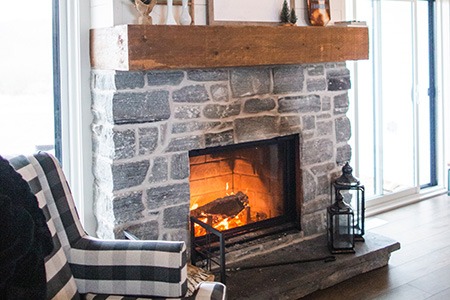
This is a fireplace chimney crafted to work with fireplace inserts (stoves). Insert chimneys are made to fit on a masonry fireplace. The stove insert is attached to the chimney using stainless steel liners. This is how the heat and smoke are cast out of the house.
Installing the fireplace insert chimney is simple, all you need to do is place the insert on a masonry fireplace and connect the chimney liners to the flu to let the heated air out of the building. Gas fireplace inserts can even have a very short chimney, which is essentially just a port where heat and gas can exit low from an exterior wall rather than through the rooftop.
Wood Burning Stove Chimneys
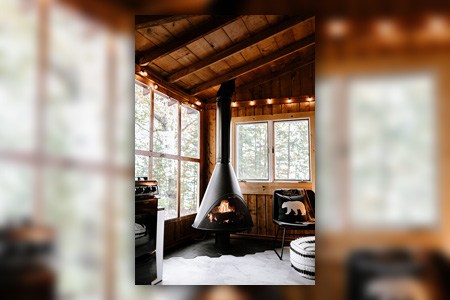
This is like bringing back old times in the recent era, even using these wood burning stove chimney styles as types of stoves. Wood-burning stoves have been in use for a long time, especially in old houses. Now it is gaining back in popularity and being installed in modern houses.
What separates a wood-burning stove from a masonry chimney and other chimneys is that it burns wood instead of gas to keep the housing warm. A chimney for a gas stove won't go through the roof; rather, it needs to be vented out through the wall.
For an outdoor patio, especially if screened-in, consider a chiminea which is another free-standing wood-burning chimney. You can use the same high heat paint for painting a chiminea as you would a stove, so you can make it match your decor perfectly, too.
Types of Chimneys That Look Good & Are Safe
Routing a fireplace to a functional chimney is the key to keeping a house warm and cozy. A common mistake amongst people is that they end up with the wrong installation and fittings. This is why we suggest you gather knowledge about the different types of chimneys before rushing on to fit one on top of your house.



